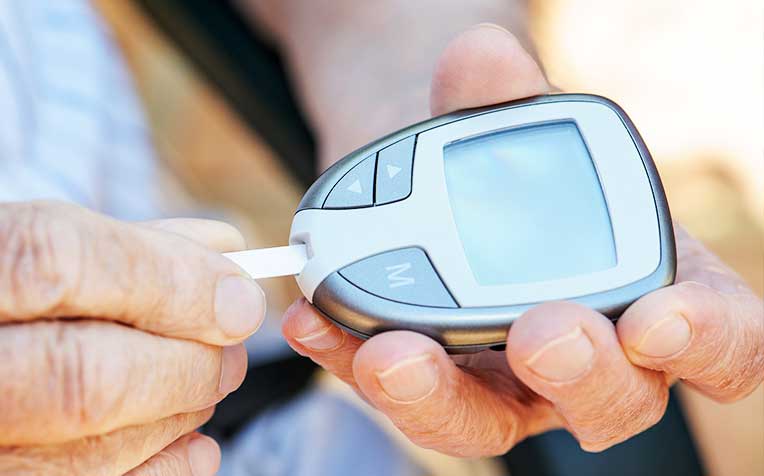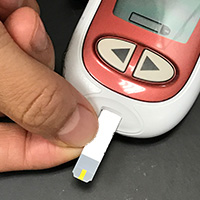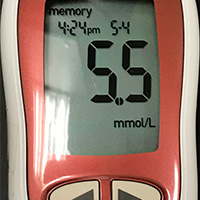
Glucometers come in a variety of sizes, storage capacity and features.
Why do you need to monitor your blood glucose levels?
One of the main aims of diabetes treatment is to keep your blood glucose levels within target range.
Blood glucose monitoring will:
- Provide a measurement of your blood glucose level at a given time
- Determine if you have hypoglycaemia or hyperglycaemia at a given time
- Enable you to know how your lifestyle and medicine regimen affect your blood glucose control
- Help you and your diabetes healthcare team to evaluate and determine the best management strategy for your diabetes
Which blood glucose meter (glucometer) should I use?
Glucometers (blood glucose meters) are available for sale in the retail pharmacy of hospitals and polyclinics. Glucometers come in a variety of sizes, different storage capacity and features. Some glucometers can also be used to check for the presence of ketones which is useful for people with type 1 diabetes or those who are otherwise susceptible to ketoacidosis.
"Choose a glucometer that suits your needs. If you are unsure which glucometers to buy, ask your doctor or nurses for a recommendation," says Senior Staff Nurse Tan Qinghua, Diabetes Nurse Educator, Department of Specialty Care Services at Sengkang General Hospital, a member of the SingHealth group.
5 steps of blood glucose monitoring
|
Step 1: Wash your hands |
 |
|
Step 2: Insert test strip |
 |
|
Step 3: Use your lancing device on the side of your fingertip to get a drop of blood |
 |
|
Step 4: Touch and hold the edge of the test strip to the drop of blood, and wait for the result |
 |
|
Step 5: Your blood glucose level will appear on the glucometer's display |

|
When should you check your blood glucose levels?
| Recommended timing | Rationale |
|
After fasting In the morning after an overnight fast (8-12 hours) before you eat or drink anything | It determines what is going on at night, especially when coupled with a bedtime reading the night before. |
|
Pre-meals 0-30 minutes before meals To correctly interpret a premeal reading, the previous meal or snack must be more than 4 hours earlier | It gives you a baseline reading of your blood glucose level before you eat. Pre-meal readings also inform you whether the rapid-acting pill or rapid-acting insulin for your last meal was adequate. |
|
Post-meals Check 2 hours after finishing your meals | This gives an estimate of how much a person’s blood glucose rises in response to certain food items. |
|
Bedtime Check more than 3 hours after dinner with no supper or snacks in between | To detect any bedtime hypoglycaemia (low blood glucose) and prevent nocturnal (night-time) hypoglycaemia. Your bedtime reading along with the next day’s fasting reading will help you understand what happens overnight to your glucose. |
| 2-4 am | To detect night-time hypoglycaemia, especially if you have symptoms during your sleep. Your doctor or nurse may ask you to do this reading if they suspect night-time hypoglycaemia. |
What should your blood glucose targets be?
The blood glucose targets given below are a general guide only. Check with your doctor or nurse about your individualised blood glucose targets.
| Test | Targets |
| Pre-meal glucose | 4.0-7.0 mmol/L |
| 2 hours post-meal glucose | < 10.0 mmol/L |
The blood glucose target can be individualised in order to prevent risk of hypoglycaemia or other adverse effects associated with tight blood glucose control.
Discuss with your doctor about your blood glucose target if in doubt.
Ways to achieve better blood glucose targets
Keeping your blood glucose levels within the target range is important to reduce the risk of diabetes-related complications.
Here are some tips to help you to achieve a better blood glucose target:
- Maintain healthy eating habits
- Adherence to diabetes treatment
- Maintain a record of your blood glucose checks and discuss the records with your doctor or nurse
Ref: O17
Also, check out our other articles on diabetes:
Easy Steps for a Healthy Diabetes Diet
Diabetes: How to Manage Blood Sugar Levels When You Fall Sick
Diabetes Foot Care: 10 Steps to Healthy Feet
Travelling with Diabetes: Tips Before You Go
Hyperglycaemia (High Blood Glucose): Symptoms to Watch Out For
Hyperglycaemia (High Blood Glucose): What To Do
Hypoglycaemia (Low Blood Glucose): Warning Signs and Symptoms
Contributed by


















 Get it on Google Play
Get it on Google Play